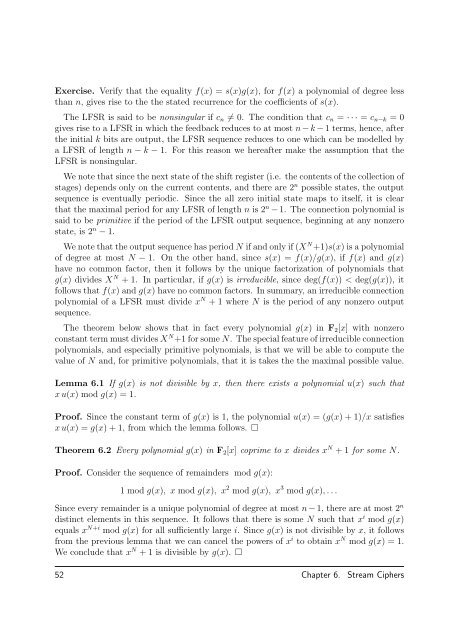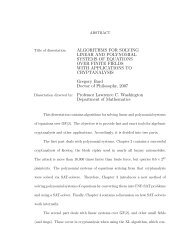Cryptography - Sage
Cryptography - Sage
Cryptography - Sage
Create successful ePaper yourself
Turn your PDF publications into a flip-book with our unique Google optimized e-Paper software.
Exercise. Verify that the equality f(x) = s(x)g(x), for f(x) a polynomial of degree lessthan n, gives rise to the the stated recurrence for the coefficients of s(x).The LFSR is said to be nonsingular if c n ≠ 0. The condition that c n = · · · = c n−k = 0gives rise to a LFSR in which the feedback reduces to at most n − k − 1 terms, hence, afterthe initial k bits are output, the LFSR sequence reduces to one which can be modelled bya LFSR of length n − k − 1. For this reason we hereafter make the assumption that theLFSR is nonsingular.We note that since the next state of the shift register (i.e. the contents of the collection ofstages) depends only on the current contents, and there are 2 n possible states, the outputsequence is eventually periodic. Since the all zero initial state maps to itself, it is clearthat the maximal period for any LFSR of length n is 2 n − 1. The connection polynomial issaid to be primitive if the period of the LFSR output sequence, beginning at any nonzerostate, is 2 n − 1.We note that the output sequence has period N if and only if (X N +1)s(x) is a polynomialof degree at most N − 1. On the other hand, since s(x) = f(x)/g(x), if f(x) and g(x)have no common factor, then it follows by the unique factorization of polynomials thatg(x) divides X N + 1. In particular, if g(x) is irreducible, since deg(f(x)) < deg(g(x)), itfollows that f(x) and g(x) have no common factors. In summary, an irreducible connectionpolynomial of a LFSR must divide x N + 1 where N is the period of any nonzero outputsequence.The theorem below shows that in fact every polynomial g(x) in F 2 [x] with nonzeroconstant term must divides X N +1 for some N. The special feature of irreducible connectionpolynomials, and especially primitive polynomials, is that we will be able to compute thevalue of N and, for primitive polynomials, that it is takes the the maximal possible value.Lemma 6.1 If g(x) is not divisible by x, then there exists a polynomial u(x) such thatx u(x) mod g(x) = 1.Proof. Since the constant term of g(x) is 1, the polynomial u(x) = (g(x) + 1)/x satisfiesx u(x) = g(x) + 1, from which the lemma follows. □Theorem 6.2 Every polynomial g(x) in F 2 [x] coprime to x divides x N + 1 for some N.Proof. Consider the sequence of remainders mod g(x):1 mod g(x), x mod g(x), x 2 mod g(x), x 3 mod g(x), . . .Since every remainder is a unique polynomial of degree at most n − 1, there are at most 2 ndistinct elements in this sequence. It follows that there is some N such that x i mod g(x)equals x N+i mod g(x) for all sufficiently large i. Since g(x) is not divisible by x, it followsfrom the previous lemma that we can cancel the powers of x i to obtain x N mod g(x) = 1.We conclude that x N + 1 is divisible by g(x). □52 Chapter 6. Stream Ciphers
















